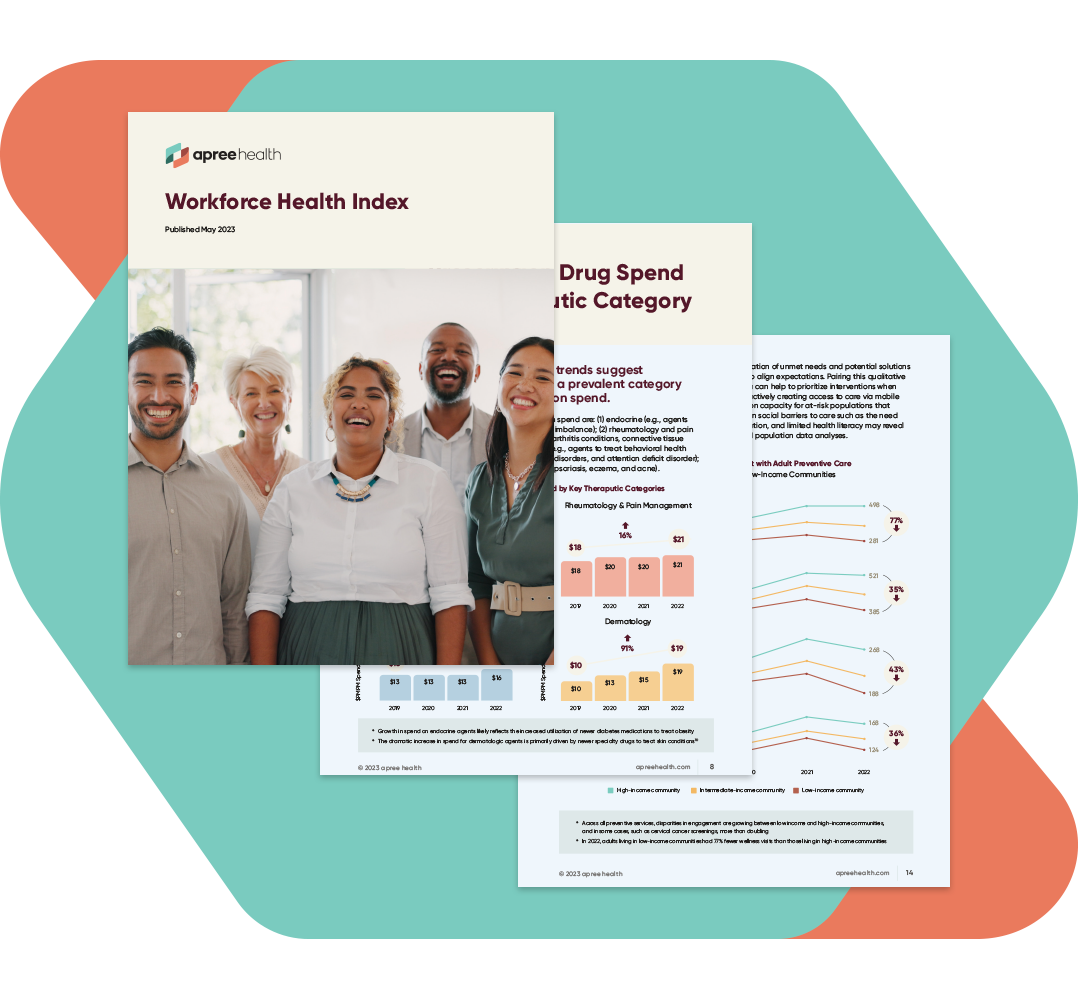SAN FRANCISCO, May 10, 2023 /PRNewswire/ — apree health, formerly Castlight Health and Vera Whole Health, today released the 2023 Workforce Health Index, providing key findings from analyses of medical and pharmaceutical spend data of its commercially-insured populations in the U.S. This year’s annual report, which is based on an analysis of more than 220 million medical and pharmaceutical claims and 4.1 million unique people, offers insights into historical trends and forecasts of 2023 medical and prescription drug spend. In addition, the report highlights the critical role of employers in engaging employees in their care, and the impact employers and payers can have on addressing the affordability and access crisis within the U.S. healthcare system. Key trends identified in the 2023 Workforce Health Index include:
Preventive Care Utilization Declines and Disparities in Healthcare Persist, Signaling More Affordability Challenges Ahead
The report identifies a concerning trend in 2022 as preventive screenings across categories, from wellness visits to colon cancer screenings, declined again and by nearly 22% in some categories. It is well established that decreased rates of preventive care contribute to increased costs over time, and that primary care engagement can prevent this with early diagnosis and management of costly conditions including musculoskeletal issues, cancer, and infectious diseases—the leading clinical categories of medical spend in this year’s Index.
“We know that engagement with value-based primary care delivers better health outcomes, reduced medical costs, and improved quality of life when conditions are detected and managed early,” said Dr. Kevin Wang, chief medical officer, apree health. “Thus, the trends in decreased primary care services in 2022 are a sign that we may see future increases in healthcare spending—this is before accounting for inflation which itself would have an exacerbating impact. The 2023 Workforce Health Index is a valuable resource to help employers and payers prioritize strategies to mitigate these risks, improve health outcomes, and reduce unnecessary costs.”
One particularly worrisome trend was observed for pediatric immunizations, which declined 25% from 2019 to 2022. This decline in immunizations for children increases the risk for the broader community and may increase absenteeism and presenteeism as working-aged caregivers tend to their sick children.
Furthermore, commercially-insured populations living in low-income communities continue to receive less preventive care than those living in high-income communities. In 2022, adults living in low-income communities had 77% fewer wellness visits than those living in high-income communities. Similar trends were also identified with pediatric wellness visits for low-income families. The 2023 Index suggests employers have an opportunity to address socioeconomic barriers to care to improve access for the most vulnerable populations.
“The best way to start tackling the healthcare affordability crisis is by addressing the lack of engagement with preventive care for all populations,” said Dr. Bruce Sherman, advisor to the National Alliance of Healthcare Purchaser Coalitions, adjunct professor at UNC-Greensboro’s Department of Public Health Education, and one of the co-authors of the report. “Employers and payers can proactively engage their benefits enrollees to better understand the specific barriers that limit use of preventive care and wellness visits. A strong focus on identifying those barriers—which often include unmet social needs—and meaningfully addressing those barriers to care is vital.”
Primary Care Engagement Delivers Positive Impact on Members’ Health
The 2023 Index reveals that engagement with primary care is associated with improved health risk and flattening of medical spend. The report compares diagnosis-based risk scores and total medical spend for individuals who had a primary care provider (PCP) visit in 2019 against the full population of those with or without a PCP visit in 2019. Individuals who had visited a PCP in 2019 had a 1% lower clinical risk score and 2% lower medical spend trends through 2021 compared to a 9% increase in clinical risk and 10% increase in medical spending for the general population. This suggests that the population under the care of a PCP was better able to manage their health two years later as compared to the general population.
“When you add the dynamic of disrupted provider-person relationships, growing labor costs, inflation, and a fragmented care landscape, that is hard for a member to self-navigate. You can see why there is a real need for employers and payers to actively and purposefully manage healthcare affordability for their populations,” said Wang.
Prescription Drug Cost Increases Due to Higher Prices, Not Utilization
The analysis of prescription drug spending found that spending on medications expanded to 28% of total commercial healthcare spend in 2022, up from 23% in 2019. Interestingly, price (rather than utilization) is the primary driver of this growth, increasing from $4.14 per days’ supply in early 2019 to $4.89 per days’ supply by the end of 2022, an 18% increase.
Given the increasing prevalence of diabetes and new indications for obesity, therapies such as Ozempic® and Wegovy® will continue to drive escalating commercial prescription drug spending. Primary care providers and obesity experts can be judicious about their prescribing decisions, trying alternative, lower-cost pathways before moving to these specialty medications. The 2023 Index outlines opportunities for employers and payers to redesign prescription, pharmacy, and medical benefits to better contain the rising costs.
View the complete 2023 Workforce Health Index for more details on the report findings. To download a copy of the report, click here.


